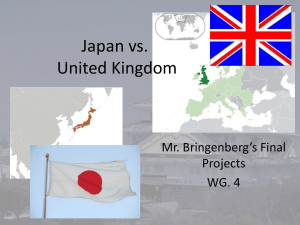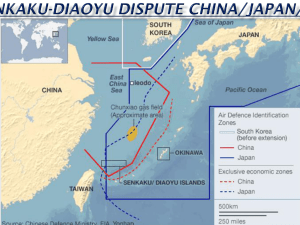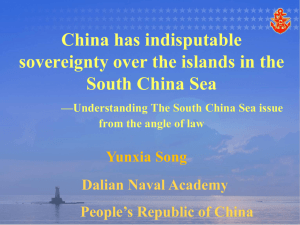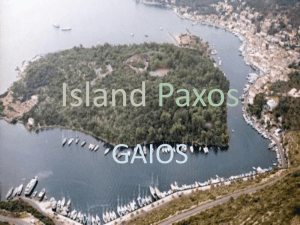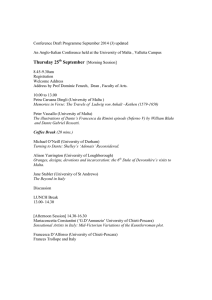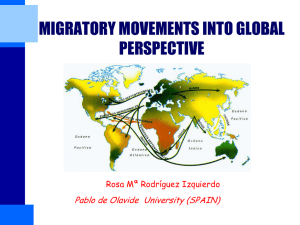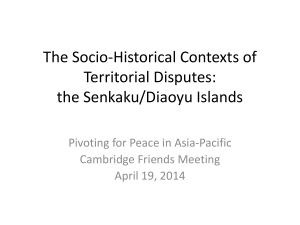Irregular Maritime Migration in Southern European Islands
advertisement
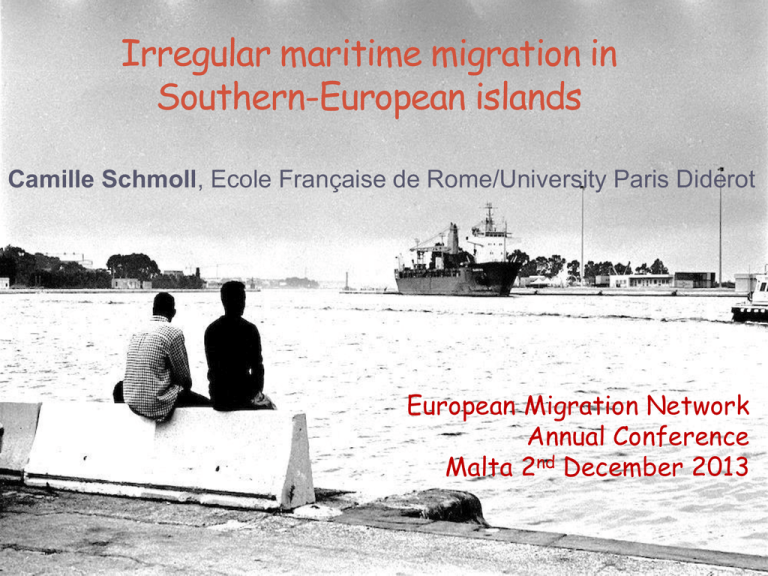
Irregular maritime migration in Southern-European islands Camille Schmoll, Ecole Française de Rome/University Paris Diderot European Migration Network Annual Conference Malta 2nd December 2013 PROGRAMME MIRIADE (Migrations IRrégulières dans les Iles et Archipels De l’Europe) 2009-2012 © Elisabeth Cosimi • Research in Malta • in 2010 and 2011 … • … and in Cyprus in 2013 Introduction • Islands as intersections of flows • Irregular migration/maritime migration • In 2002 the estimated number of irregular migrants residing in the EU-12 was 3.1–5.3 million. By 2008, this number dropped to 1.8–3.3 million in the EU-12 and 1.9– 3.8 million in the EU-27 (Düvell 2011). Structure of the presentation 1. A short chronology of maritime migration to Southern European islands How and why the issue has become salient? 2. Why look at islands? Islands as ordinary places Islands as ‘places of condensation’ from which to observe the EuroMediterranean migratory situation 3. Research themes and future directions Bordering the islands Analysing and challenging narratives of islandness Migrants and the local population 1. A short chronology of irregular migration to Southern European islands • A persistent phenomenon since Italy and Spain introduced visa requirements in the early 1990s’ • The geography and structure of the flows evolve constantly according to institutional factors A chronology in 5 steps 1/ Irregular migrations in the Mediterranean – End of 1990’s 2/During the 2000’s, trajectories to Europe are constantly reshaped according to the geography of border controls. From Gibraltar to the Canary Islands and Strait of Sicily 3/ The Greek route Apprehensions Greek border Crete Turkish 2007 sea 16,781 2,245 112,364 TOTAL (including land borders and within the country) 2008 2009 2010 2011 2012 30,149 27,685 6,204 814 3,610 2,961 2,859 2,444 1,784 2,834 146,337 126,145 132,524 99,368 76,878 Triandafyllidou, 2014, forthcoming 4/ 2010: interruption of flows to Sicily and Malta, mainly due to the strengthening of the long-lasting cooperation between Italy and Libya. Sicily 1999 2000 2001 2002 2003 2004 2005 2006 2007 1,973 2,782 5,504 18,225 14,017 13,594 22,824 21,400 16 182 Sardinia 2008 2010 2011 16,585 34,540 8,282 107 50,483* 1,548 318 1,621 2009 484 All Italy 49,999 26,817 20,143 23,719 14,331 13,635 22,939 22,016 20,165 36,951 9,573 4,406 62,692 * Data here refer to Lampedusa only. Malta Year 2001 2002 2003 2004 2005 2006 2007 2008 2009 2010 2011 2012 (as of 6 July) Irregular immigrants 57 1,686 502 1,388 1,822 1,780 1,702 2,775 1,397 28 1,577 1,203 Source : Triandafyllidou, 2014, forthcoming 5/ The situation changed dramatically with the Tunisian revolution and the war in Libya, exposing the fragility of EU externalisation policies. Irregular migrants 2011 (Frontex) 2. Why look at islands? → Islands as ordinary places • A rather small number of irregular migrants pass illegally through European islands • They share may common features with other EU or African places in the Euromed region • Most of the European islands we look at – Greek islands, Italian, Spanish islands, even Malta and Cyprus - belong to what has been described extensively as the “South European migration model” (King Thomson 2008) 2. Why look at islands? → Islands as « places of condensation » • Islands are socially constructed as bastions of European jurisdiction and identity • Narratives of islandness and their interactions with the social construction of Europeanness • Island features, islandness and the social construction of ‘geographies of fear’ and ‘geographies of hospitality’ and cosmopolitanism (Shirlow and Pain 2013) The issue of size Geographical debates on the web (Malta Today, 03/09/2013) • “POSTED BY: Avukat — 03/09/2013 14:37:32 • In Somalia There are 16.12 Somalis per sq km In Malta there are already • • • • • • 16.66 Somalis per sq km. What now Malmstrom? POSTED BY: giuseppe schembri bonaci — 03/09/2013 11:16:12 What a cunning argument. The problem is the population density not the ratio to the population! This is the whole problem. This shows the lack of sincerity and solidarity coming from other European countries. POSTED BY: johnmicallef — 03/09/2013 10:34:14 What this article fails to compare is the huge discrepancy between the population density of the 2 countries. (ppl/mil2) Malta 3,421 vs Sweden 60. This is the most important data in my opinion. POSTED BY: mtvmalta — 03/09/2013 08:58:34 Ahfruli li bl-Ingliz: I do not have the favour of the massive bureau Swedish commissioner Cecilia Malmström enjoys the favour of, but I shall quote from Asylum trends statistics for 2008, as they result in a June 2009 publication by the Immigration and Naturalisation Service of The Netherlands reveal that when considered according to country area size, “Malta received by far and away the largest number of asylum applications in Europe: 8.254 per 1.000 sq km, more than 100 times more than the EU average (55 per 1.000 sq km)”. Cyprus and Belgium ranked second and third at a large distance with about 10 times more applications than the EU average” The issue of size “Dearest women, I received your petition, and I also addressed it to the Italian and the European institutions that could give an answer to your questions. As the mayor of Lampedusa, the island which saves the life of many people, forced to journeys of hope or that has mercy upon the corpses returned from the sea, I feel the duty to take your demand of truth; and to give you my little aid, as much little as little are my small island and my voice. You are big, and also your sorrow , your perseverance, and your strength to refuse the silence and resignation, your voice. I hope that I could still go with you, and to be your sister along the way. A big hug and greetings Giusi Nicolini” Letter to the mothers and families of Tunisian missing migrants (20/07/2013) 2. Why look at islands? • Compelling places to look at new modes of migration management. As such, they reveal the growing complexity of the bordering process. • Baldacchino (forthcoming) : because of their “small (read more manageable) size, their separation and distance from the mainland, islands are rendered as convenient laboratories for entrepreneurial political engineering, and equally convenient sites for research on the same” • The smallness allows us to have an overview of the various actors involved in the migratory process. 2. Why look at islands? - Being an island state….or not - Insularism - The evolution of migration and migration policy in the European context leads us to rethink and question the ‘centrality’ and/or ‘peripherality’ of islands with reference to different geo-political contexts 3. Research themes and future directions a/ Bordering the islands • Track the multiple configurations of borders and to go beyond the “territorial epistemology” of the border (Parker, Vaughan Williams, 2009, SI of Geopolitics) • Borders as lived and managed spaces, sites of conflict and negotiation, whose outlines are moving and punctual, rather than fixed and linear. Island spaces as gatekeepers: ‘sentinel’ islands Clochard and Migreurop, 2013 b/ Analysing and challenging narratives of islandness • Critically engage with an univoque conception of islands as places of transit • ‘counter-islandness’ in order to rethink and challenge classical arguments about the nature of islands • The three ‘‘I’’: imagination, immobility, isolation • Articulation of scales / Processes of rescaling (Brenner, Smith, Marston) • the analysis of movement (versus immobility) showing how migrants concrete daily experiences consist of multiples circulations, plural social ties and diverse spatial practices. Malta at the heart of a complex circulatory system: a tentative typology • The island as a barrier • The island as a hub • The island as a place of settlement c/Migrants and the local population • Protests • Different reactions from the local population • Solidarity • New forms of cosmopolitanism and hospitality?
